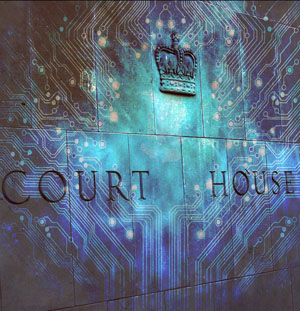Provincial plans for a comprehensive electronic system for Ontario’s courts are once again up in the air as the government takes another stab at reviewing “all our information technology needs and priorities.”
 User training for the Court Information Management System — that one document claims will “fundamentally alter internal and public access to the courts” —was to begin in spring 2012 under a phased implementation plan.
User training for the Court Information Management System — that one document claims will “fundamentally alter internal and public access to the courts” —was to begin in spring 2012 under a phased implementation plan.
But according to Ministry of the Attorney General spokesman Jason Gennaro, it hasn’t yet happened as the government once again looks to determine an implementation date.
“As with all projects, it is necessary to periodically review the status to ensure we are meeting our goals,” he said.
“We’ve engaged external specialists to review the progress made on CIMS to date and provide us with advice about where we should go from here. As part of our commitment to modernize court operations, we are reviewing all our information technology needs and priorities.”
The development is only the latest in a long series of struggles at the ministry to get a comprehensive court technology system off the ground that would allow for enhancements such as electronic document filing. As Law Times reported earlier this month, Ontario Auditor General Jim McCarter’s annual report noted the government is also reviewing the Crown Management Information System that allows for tracking of criminal prosecutions. The government hinted it might scrap that system as costs exceed the original budget.
In the meantime, the government has been spending lots of money on its various technology efforts. According to ministry spokesman Brendan Crawley, spending over the last six years on the existing systems that mainly provide case-tracking and scheduling functions — ICON, FRANK, and Estates — was $13.8 million. Spending so far on CIMS is $9.9 million, which according to Gennaro is the amount the government budgeted.
But while the spending continues, numerous documents show the ministry’s repeated difficulties in getting a comprehensive system that allows electronic document filing and retrieval off the ground.
Auditor general’s reports from the last decade, for example, have made repeated references to the issue:
• In 2010, a followup section in the auditor general’s report containing a previous examination of technology services noted the ministry’s vow to have a first version of CIMS, a system aimed at integrating existing programs with enhanced functionality, ready by spring 2012. According to the report, the government had determined that “no one vendor offered a court information management system that could replace its existing legacy systems and that the costs and risks of migrating to a new system using several vendors would be high.”
• The 2010 report followed an examination in 2008 that noted the ministry had obtained cabinet approval four years earlier for “essential upgrades” to ICON and FRANK in order to position them for future integration into a planned single case-management system. At the time, the target date for a single case-management system was 2009-10. The report also stated British Columbia had successfully implemented a single system in 2001 at a cost of $15 million. In response to a recommendation to expedite its efforts, the ministry vowed to continue working on the issue.
• In 2005, another followup from an earlier recommendation to upgrade court technology pointed to “limited progress” on the issue. In fact, the auditor general said the ministry had discontinued electronic form filing efforts inherited from the Integrated Justice Project, an earlier system cancelled in 2002.
• The 2005 comments followed a 2003 auditor general’s report that noted ICON had been outdated for several years. According to the 2003 report, the government cancelled the much-ballyhooed Integrated Justice Project in 2002 due to “cost increases and delays.” The report also reiterated the need for “timely implementation of new technologies.” In response, the ministry said it was working on FRANK, a program that provides case tracking but doesn’t provide access to court documents themselves.
• In 2001, the auditor general reviewed the Integrated Justice Project, an effort launched by the ministries of the attorney general and solicitor general in 1996. The report concluded the project had experienced significant cost increases and delays and called for greater financial and internal controls over it.
• Besides the auditor general’s reports, documents on the various court technology programs tried by the government over the years and obtained by Law Times through a freedom of information request indicate some of the long-standing struggles with the software. A 2001 threat assessment for the ICON program, for example, noted ICON had no intrusion-detection or anti-virus software installed on it. “This creates the possibility that, should an unauthorized access of the ICON system occur, it may go undetected for 24 hours,” the threat assessment stated.
In addition, the threat assessment pointed to problems related to high attrition and increased workloads and the need for user-education sessions for employees. It also called for the implementation of a security policy.
“Current staffing is at a minimum level,” the report stated. “The training of a new staff member or the further training of a current staff member is difficult to effect because the absence of any one staff member to be trained places a greater workload on the remaining staff members. This understaffed condition lowers morale and increases the workload per staff member, which may contribute to the risk of errors and/or omissions.”
Interestingly, while the 2001 report highlighted some of the security issues with ICON, later reports on FRANK were much more favourable.
“The implementation of FRANK does not raise serious privacy concerns,” stated a 2003 privacy impact assessment. A 2004 assessment of the second version of FRANK, an upgrade of the original software to an Oracle database from a Microsoft Access client server once planned for 2006, said much the same thing.
Asked why the government has had so much difficulty getting a more comprehensive system off the ground over the years, Gennaro pointed to the complexity of the task.
“Ontario is one of the largest court jurisdictions in North America with extensive criminal, family, civil, small claims, and provincial offences operations,” he said. “In such a complex environment, modernizing the support systems is a large undertaking.”
For former Ontario attorney general Charles Harnick, the time has come to see real progress.
“I think it goes without saying that it’s long overdue,” said Harnick, who was AG in the late 1990s when the Integrated Justice Project was launched and now works as a mediator and arbitrator in Toronto.
Harnick said while the Integrated Justice Project had some success on the corrections side of the bureaucracy, it had more difficulty at the Ministry of the Attorney General.
“The Integrated Justice Project ended without the case-management system that everyone really wanted,” he says, citing disagreements that led to the project’s cancellation after he left politics in 1999.
Harnick doesn’t fault anyone for those problems and echoes Gennaro’s comments about the difficulty in integrating a system as complex as Ontario’s.
“There are so many other day-to-day things that people are worried about,” he said, noting the need for a “champion” within the government to move the issue forward.
In particular, Harnick highlighted the challenge of justifying the cost of new systems given the need to prove immediate benefits to the public. In addition, he said when the Integrated Justice Project began, there were few systems from other jurisdictions that could serve as models Ontario could adapt.
“We were very early in the process. There weren’t a lot of governments to look at who were developing technology on that scale. Today, I suspect that’s different.”
For its part, the ministry denies it has dropped the ball on technology.
“We have made real progress on modernizing court services in Ontario,” said Gennaro.
“For example, digital court recording has been implemented in almost 1,000 courtrooms and hearing rooms across the province and is a great success. In recent years, five case-tracking applications have been decommissioned and replaced with the provincial FRANK system. The justice video network is enhancing access to justice by providing video conferencing services in the courtroom for witnesses, interpreters, and the accused from almost anywhere in the world.
“Two years ago, the ministry launched the Ontario court forms assistant, an online tool that helps people fill out 13 of the most commonly used family and Small Claims Court forms quickly and easily.”
But for Harnick, while the challenges in overhauling the system are significant, the lack of progress is evident.
“We’re 15 years out and we’re really no further ahead,” he said.
 User training for the Court Information Management System — that one document claims will “fundamentally alter internal and public access to the courts” —was to begin in spring 2012 under a phased implementation plan.
User training for the Court Information Management System — that one document claims will “fundamentally alter internal and public access to the courts” —was to begin in spring 2012 under a phased implementation plan.But according to Ministry of the Attorney General spokesman Jason Gennaro, it hasn’t yet happened as the government once again looks to determine an implementation date.
“As with all projects, it is necessary to periodically review the status to ensure we are meeting our goals,” he said.
“We’ve engaged external specialists to review the progress made on CIMS to date and provide us with advice about where we should go from here. As part of our commitment to modernize court operations, we are reviewing all our information technology needs and priorities.”
The development is only the latest in a long series of struggles at the ministry to get a comprehensive court technology system off the ground that would allow for enhancements such as electronic document filing. As Law Times reported earlier this month, Ontario Auditor General Jim McCarter’s annual report noted the government is also reviewing the Crown Management Information System that allows for tracking of criminal prosecutions. The government hinted it might scrap that system as costs exceed the original budget.
In the meantime, the government has been spending lots of money on its various technology efforts. According to ministry spokesman Brendan Crawley, spending over the last six years on the existing systems that mainly provide case-tracking and scheduling functions — ICON, FRANK, and Estates — was $13.8 million. Spending so far on CIMS is $9.9 million, which according to Gennaro is the amount the government budgeted.
But while the spending continues, numerous documents show the ministry’s repeated difficulties in getting a comprehensive system that allows electronic document filing and retrieval off the ground.
Auditor general’s reports from the last decade, for example, have made repeated references to the issue:
• In 2010, a followup section in the auditor general’s report containing a previous examination of technology services noted the ministry’s vow to have a first version of CIMS, a system aimed at integrating existing programs with enhanced functionality, ready by spring 2012. According to the report, the government had determined that “no one vendor offered a court information management system that could replace its existing legacy systems and that the costs and risks of migrating to a new system using several vendors would be high.”
• The 2010 report followed an examination in 2008 that noted the ministry had obtained cabinet approval four years earlier for “essential upgrades” to ICON and FRANK in order to position them for future integration into a planned single case-management system. At the time, the target date for a single case-management system was 2009-10. The report also stated British Columbia had successfully implemented a single system in 2001 at a cost of $15 million. In response to a recommendation to expedite its efforts, the ministry vowed to continue working on the issue.
• In 2005, another followup from an earlier recommendation to upgrade court technology pointed to “limited progress” on the issue. In fact, the auditor general said the ministry had discontinued electronic form filing efforts inherited from the Integrated Justice Project, an earlier system cancelled in 2002.
• The 2005 comments followed a 2003 auditor general’s report that noted ICON had been outdated for several years. According to the 2003 report, the government cancelled the much-ballyhooed Integrated Justice Project in 2002 due to “cost increases and delays.” The report also reiterated the need for “timely implementation of new technologies.” In response, the ministry said it was working on FRANK, a program that provides case tracking but doesn’t provide access to court documents themselves.
• In 2001, the auditor general reviewed the Integrated Justice Project, an effort launched by the ministries of the attorney general and solicitor general in 1996. The report concluded the project had experienced significant cost increases and delays and called for greater financial and internal controls over it.
• Besides the auditor general’s reports, documents on the various court technology programs tried by the government over the years and obtained by Law Times through a freedom of information request indicate some of the long-standing struggles with the software. A 2001 threat assessment for the ICON program, for example, noted ICON had no intrusion-detection or anti-virus software installed on it. “This creates the possibility that, should an unauthorized access of the ICON system occur, it may go undetected for 24 hours,” the threat assessment stated.
In addition, the threat assessment pointed to problems related to high attrition and increased workloads and the need for user-education sessions for employees. It also called for the implementation of a security policy.
“Current staffing is at a minimum level,” the report stated. “The training of a new staff member or the further training of a current staff member is difficult to effect because the absence of any one staff member to be trained places a greater workload on the remaining staff members. This understaffed condition lowers morale and increases the workload per staff member, which may contribute to the risk of errors and/or omissions.”
Interestingly, while the 2001 report highlighted some of the security issues with ICON, later reports on FRANK were much more favourable.
“The implementation of FRANK does not raise serious privacy concerns,” stated a 2003 privacy impact assessment. A 2004 assessment of the second version of FRANK, an upgrade of the original software to an Oracle database from a Microsoft Access client server once planned for 2006, said much the same thing.
Asked why the government has had so much difficulty getting a more comprehensive system off the ground over the years, Gennaro pointed to the complexity of the task.
“Ontario is one of the largest court jurisdictions in North America with extensive criminal, family, civil, small claims, and provincial offences operations,” he said. “In such a complex environment, modernizing the support systems is a large undertaking.”
For former Ontario attorney general Charles Harnick, the time has come to see real progress.
“I think it goes without saying that it’s long overdue,” said Harnick, who was AG in the late 1990s when the Integrated Justice Project was launched and now works as a mediator and arbitrator in Toronto.
Harnick said while the Integrated Justice Project had some success on the corrections side of the bureaucracy, it had more difficulty at the Ministry of the Attorney General.
“The Integrated Justice Project ended without the case-management system that everyone really wanted,” he says, citing disagreements that led to the project’s cancellation after he left politics in 1999.
Harnick doesn’t fault anyone for those problems and echoes Gennaro’s comments about the difficulty in integrating a system as complex as Ontario’s.
“There are so many other day-to-day things that people are worried about,” he said, noting the need for a “champion” within the government to move the issue forward.
In particular, Harnick highlighted the challenge of justifying the cost of new systems given the need to prove immediate benefits to the public. In addition, he said when the Integrated Justice Project began, there were few systems from other jurisdictions that could serve as models Ontario could adapt.
“We were very early in the process. There weren’t a lot of governments to look at who were developing technology on that scale. Today, I suspect that’s different.”
For its part, the ministry denies it has dropped the ball on technology.
“We have made real progress on modernizing court services in Ontario,” said Gennaro.
“For example, digital court recording has been implemented in almost 1,000 courtrooms and hearing rooms across the province and is a great success. In recent years, five case-tracking applications have been decommissioned and replaced with the provincial FRANK system. The justice video network is enhancing access to justice by providing video conferencing services in the courtroom for witnesses, interpreters, and the accused from almost anywhere in the world.
“Two years ago, the ministry launched the Ontario court forms assistant, an online tool that helps people fill out 13 of the most commonly used family and Small Claims Court forms quickly and easily.”
But for Harnick, while the challenges in overhauling the system are significant, the lack of progress is evident.
“We’re 15 years out and we’re really no further ahead,” he said.







